The Spirit of Jadeite Carving
June 18, 2014
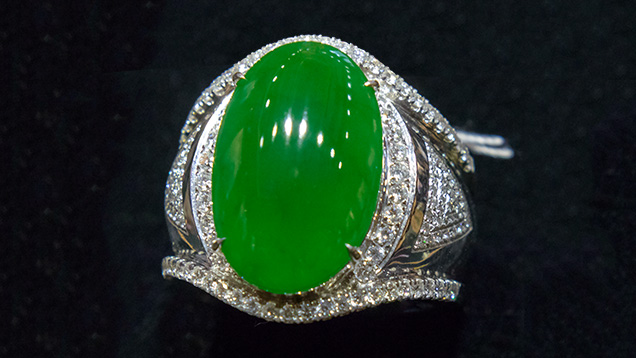
For a long time, jadeite was traded mainly out of the palace. When the Empress Dowager Cixi ruled China at the end of the Qing Dynasty (1861 to 1908), she started to collect high-quality jadeite from all over the country to satisfy her own desires. This trend also swept over the whole royal family and the upper social class. By 1908, jadeite was already the most expensive jade sold in Beijing’s most famous antique market, Liu Li Chang. Jadeite and nephrite have shared high market status ever since.
Three-dimensional jadeite carving: Shan Zi
It’s well known that jadeite can be shaped into different jewelry styles such as bracelets, rings, cabochons, and more, but China’s cutters also process this material into larger-scale decorations. These decorations are called “Shan Zi” in Chinese. “Shan” means hills or mountains, indicating that the jadeite was carved to preserve its original outline and shape. Compared to other methods, Shan Zi is probably the most natural way to process jadeite rough, but it is also the most expensive and time-consuming process.There are also other ways to fashion jadeite. For example, some people slice jadeite rough into thin plates and then create cameos on the surface. This produces more-finished products from the same amount of material and can increase transparency as well.
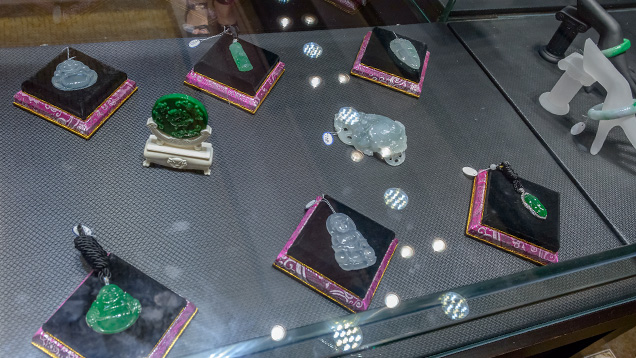
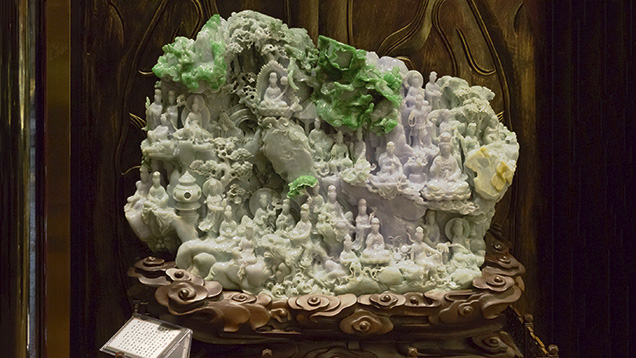
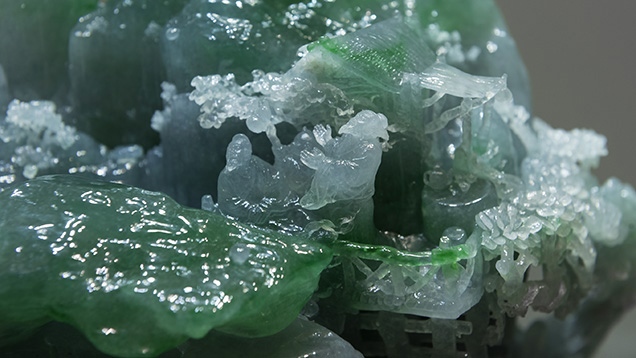
Acquiring the material
In June 2013, a group of GIA staff members visited one of southern China’s jadeite hubs. In Sihui, the authors were introduced to Mr. Zheng, the president of Mazu Jade Articleco., Ltd., and his close friend Mr. Fang, the president of Jingyu Mantang jadeite carving workshop. These two gentlemen warmly welcomed us and hosted our visit and showed us one of their ongoing carving projects.They obtained the jadeite they were working on in 2004, at a public auction in Myanmar. It was separated from an even bigger jadeite boulder. They were not able to get the other half, which remained in Myanmar. The boulder they brought back weighed about eight tons, and they cut it into two pieces. One is now being carved to make a huge jadeite Shan Zi. The other part was further divided into three pieces to be carved into the three Chinese gods: Fu, Lu, and Shou.
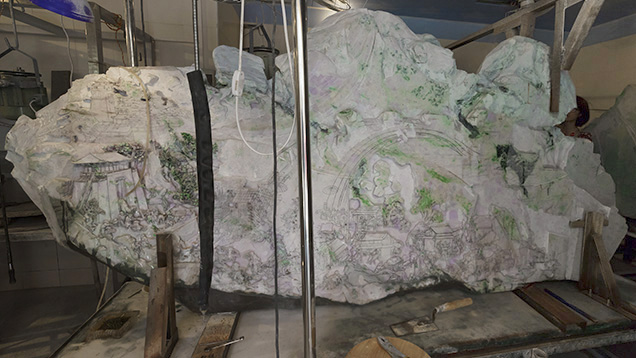
Mr. Fang also pointed out that they would have profited more if they had used this material to make bangles, since bangles with full green or purple colors are usually worth several million RMB each. They could have produced a large number of bangles from this giant piece of rough. The reason they decided to make it into a Shan Zi was that, as an artist, Mr. Fang had always dreamed of finishing a masterpiece in his lifetime and both gentlemen sensed that this might be the opportunity to do it.
Inspiration and theme selection
Mr. Fang is the chief designer of the piece. Working along with two other designers and six highly skilled carvers, it will probably take about five to six years to finish.When asked about his design inspiration, Mr. Fang became very excited. This rough sat in the workshop from 2004 to 2010 because he could not find a suitable theme to base its design on. Then, in 2010, he attended the Shanghai Expo. In the China pavilion, he saw an amazing 3-D dynamic painting called Qingming Shanghe Tu (Along the River During the Qingming Festival). The 3-D painting inspired Mr. Fang, and he returned to Sihui the same day to plan the execution of this theme on his jadeite rough.
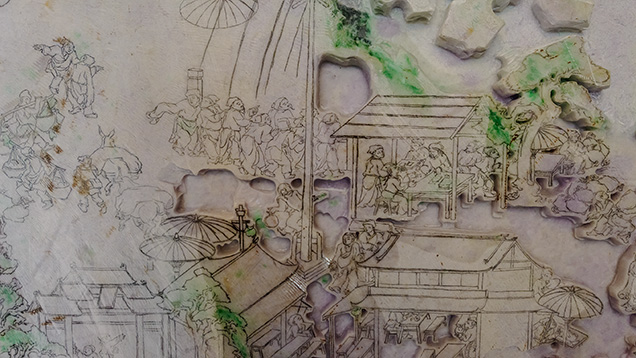
The visiting team was shown the pencil sketch on the jadeite and some parts that have been worked on already. Mr. Fang also showed us the back of the rough, which will also be carved to represent parts of the painting.
In the room next to the workshop, progress was being made on the carving of the three gods: Fu, Lu, and Shou, made from a portion of the same rough material. The first pencil sketch has been finished. Mr. Fang pointed out that the design might be changed here and there as work progresses because jadeite color distribution is very complex and it can change within centimeters.
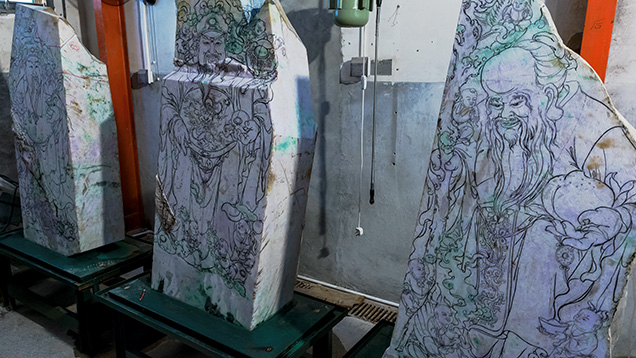
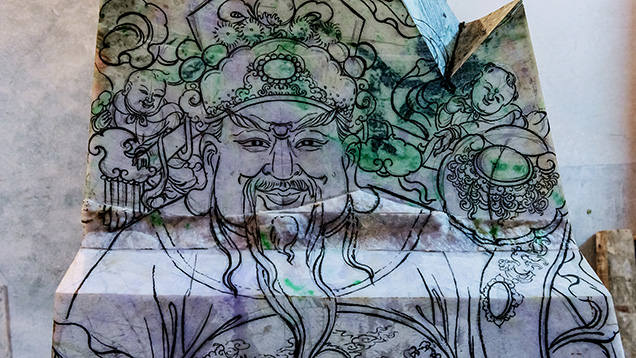
A dedicated jadeite carver
Mr. Fang’s full name is Xingchun Fang. He was born in 1975 in Putian, Fujian province, which is a town that’s famous for its wood carvings. Mr. Fang began learning wood carving when he was very young. This gave him a very solid base in the art and led him to the world of jadeite carving later in his life.Mr. Fang arrived in Sihui as a 17-year-old in 1992. He started his jadeite carving career as a worker in various workshops. He practiced jadeite polishing and simple carving techniques every day. Many people felt that the job was too boring and left, and Mr. Fang was one of the very few who stayed.
After a year or so, he opened his own small business, carving small pendants for dealers to sell. Although small pendants were the mainstream products on the market back then, Mr. Fang felt that it was not what he wanted to do as an artist. Finally, he successfully persuaded a dealer to let him make a small-scale 3-D Shan Zi for him. The dealer sold the product and made a good profit. This inspired more dealers to ask Mr. Fang to make large jadeite carvings for them.
With the development of his own business, Mr. Fang gradually gained the purchasing power to buy his own jadeite rough. After experiencing ups and downs, he finally got the business on the right track. In 2003, he started to collaborate with Mr. Zheng from Mazu. Mr. Fang was in charge of design. During their collaboration, Mr. Fang created many award-winning masterpieces that helped Mazu gain its fame and status in Sihui as the best jadeite carving company.
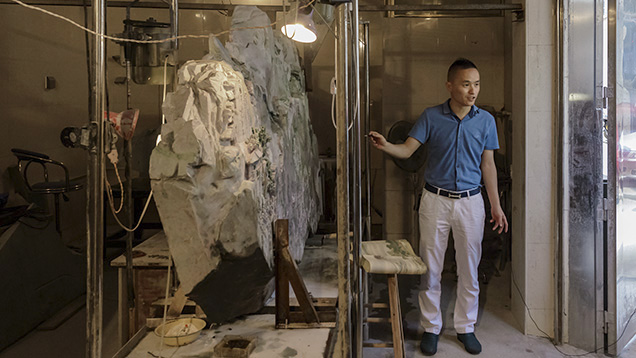
As a successful young jadeite carving artist, Mr. Fang has always kept in mind that to become a great jadeite carver, one should have the same strong properties as jadeite. He also believes that there is a subtle connection between him and jadeite, and between him and his friends who share the same interests and passion.
Dr. Tao Hsu is a technical editor of Gems & Gemology. Mr. Andrew Lucas is manager of field gemology for education at GIA Carlsbad.
The authors gratefully acknowledge the assistance provided by Mr. Wenshui Zheng and Mr. Xingchun Fang during our visit in Sihui. We would also like to thank Miss Shumin Cao and Mr. Qinghong Guo from Guangdong Gemstones & Precious Metals Testing Center for introducing us to local industry leaders and providing us with ground transportation. Special thanks go to Miss Kiki Ho from Guangzhou Jewelry Chamber of Commerce, who acted as our interpreter in Guangzhou.



